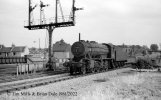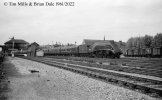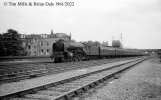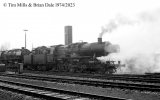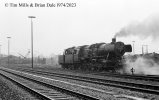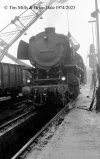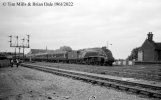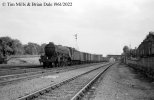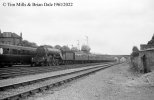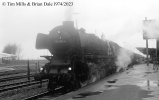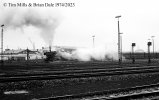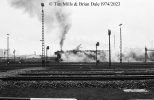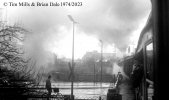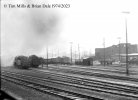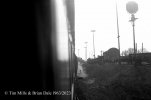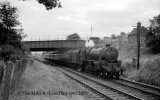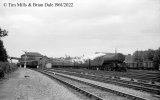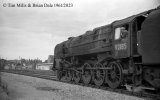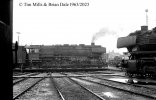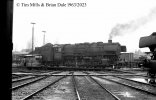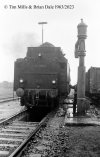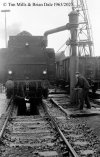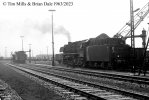Now most of the basic work is completed in collecting the data from at least the recent postings I can start to address the kind comments which have accrued since my last picture postings.
Brian McKenzie has kindly been in touch and commented that the (for example) German photos may get lost within the more general UK photos. He suggested that the "Threadmarks" facility could be useful so, just as a try out, all the posts which include Tim's photos from Germany are now identified as "Includes German Railways 1974". If this is helpful I'll extend it in to all those posts containing non - UK railways subjects.
Thanks too, Graham Dog Star, for policing these photos and for advising when you pick up images which might have originated here. On the whole keeping them within WT has been successful and there appear to have been very few "leaks".
Arun, Yorkshire Dave (with additional thanks for identifying the location of the Emden photo), Roger, Brian and Barry (diversions to other countries are encouraged), Mickoo, Simon and Michael. Thank you for a full and possibly complete review of the Kabintenders. All retained in a separate document which will contain comments about all the German photos so eventually will be available in one place together with the associated non-German railway references by brief title. These particular posts may generate a pdf against the photo which kicked it off as the detail is quite significant.
Andy, David and Simon. Thanks for yours re Old Oak. That is, of course, generic information which would suit so many of Tim's pictures that it was a problem for me to decide how it should be kept. Eventually I've decided to have an "Old Oak Common" pdf post which will appear shortly containing the information references and comments.
Arun and Roger. Re HS2 - I definitely agree regarding the GC main line. If the land had been retained in a land bank when the line closed life would have been so much easier! As far as the nimbys are concerned, Arun, I can speak as one peripherally affected by HS2 although a good few miles away. As a project it was never properly costed and I guess now never will be. Would it have gone ahead if the costs had been recognised earlier? Who knows? From what I can see locally the major concern which has generated so much anti feeling is the vast amount of land taken for the project. I'm sure it'll be returned to some sort of landscaped character once complete but in large part the land has been damaged irreparably, frequently by the felling of 100+ year old trees and in some cases entire copses which will give the developers a great opportunity to get in. IMHO it's just a shame that the project has been so badly managed and is now emasculated by truncating the project at Birmingham. Anyway, that's enough of that and I'll be saying nothing further in the way of comment on future posts, should there be any. Nor will I be keeping a pdf!
Moving on to Mickoo's comments on that pdf. Firstly many thanks, Mick, for taking so much trouble. Even with the relatively small numbers of images I've dealt with so far the amount of effort involved is significant. Nevertheless it is my humble belief that the images and the effort put in to responding by WT members deserve protecting so I'll continue. Following your suggestion I will add the originating photo to the head of the document which seems a patently good idea.
In the vast majority of cases the collected data is limited to my own comments or maybe one or two supplementaries which fit neatly within the Properties/Details associated with each of the photos so I won't be creating an associated pdf for every picture. While that doesn't make such comments immediately available to viewers on WT all those comments appear within adjacent posts so are not lost as far as public consumption is concerned.
I'll also refresh the titles for the pdfs as I can see that referencing them only by img number may work for me but does not help when viewed in isolation. In order that they appear alongside the relevant photo master in my files the description will be imgXXX Post # Brief Description.
Bearing the above in mind I'll refresh the pdfs I've created so far and they will appear as final versions within the Tim Mills Photos thread. One of the early improvements will be to ensure that all images have a "Copyright" stamp printed over them which was lacking on the example pdf I've shown. Maps etc where the copyright or origination is stated in the text will not be so adorned.
Adrian - WT is such a fund of information I'm much comforted by your stated intention that it will continue in to the far future. I know how much your work to keep the site up to date and secure is appreciated and there is wide recognition of the time it takes to do this.
Thank you Simon for the final info re 2888 which I suspect completes that particular journey.
Martin and Adam - it's interesting that a published work can get something so wrong, particularly when it may be regarded as a reference. I've done a bit of proof reading, particularly for instructions, and it's surprisingly difficult and a skill I'm still having to learn. In fact every document I've reviewed so far will need some element of correction once we've had comments from users but my understanding is that it's not terribly unusual for that to be the case, particularly with what may be loosely described as technical documentation..
It's about time we had some more photos so those, UK and German, will follow.
Brian



